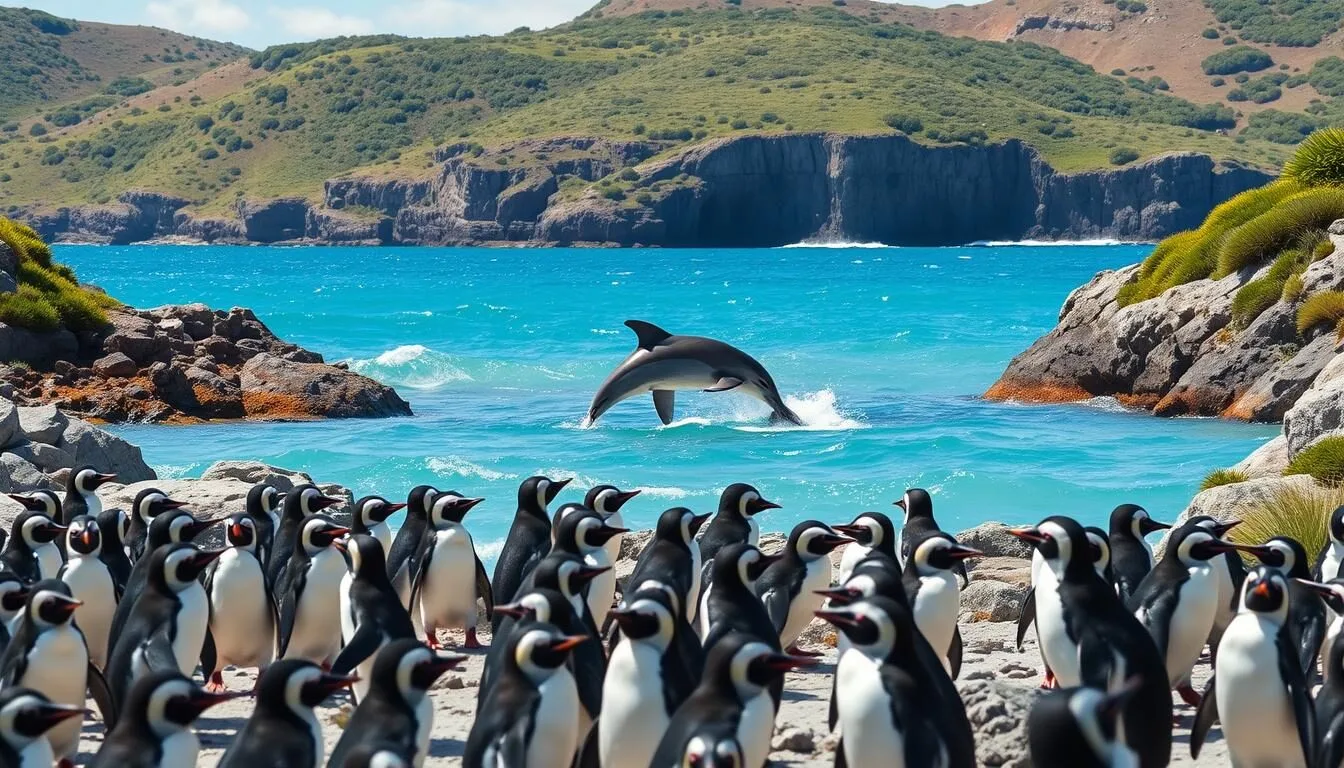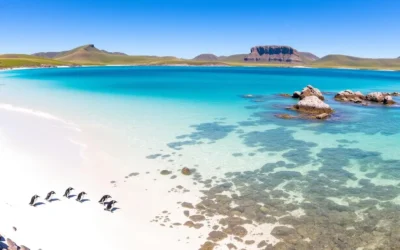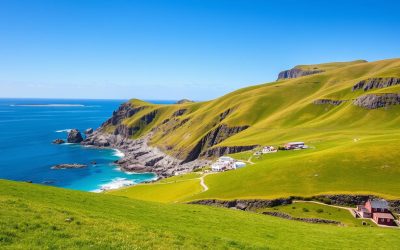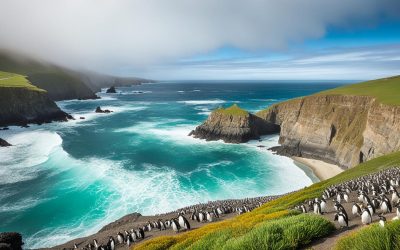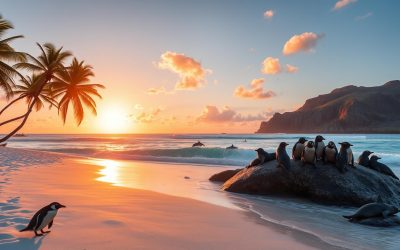✓ Accommodations ✓ Flights ✓ Rental Cars ✓ Tours & Activities
Did you know that the Falkland Islands are home to over 200,000 penguins, making it a paradise for wildlife enthusiasts?
Planning a trip to this remote archipelago requires understanding its unique climate patterns. The cool, windy climate means that the experience varies dramatically depending on when you visit. With two main seasons – the Austral summer and winter months – your wildlife encounters and cultural opportunities will differ significantly.
To make the most of your trip, it’s crucial to choose the right time to visit based on your interests and weather preferences. Whether you’re looking for wildlife experiences or cultural events, understanding the weather patterns will enhance your adventure.
Understanding the Falkland Islands Climate
The Falkland Islands experience a distinct subpolar climate influenced by the South Atlantic weather patterns. You should understand that the climate here is quite unique, with persistent westerly winds blowing throughout the year.
The South Atlantic Weather Patterns
The Falkland Islands are characterized by a unique South Atlantic weather system. Frequent weather fronts pass over the archipelago, bringing clouds, rain, or snow, interspersed with short-lived sunny intervals. The influence of the sea moderates the climate, resulting in relatively stable temperatures.
- The islands experience a year-round pattern of rapidly changing weather conditions.
- Precipitation is fairly evenly distributed throughout the year, averaging around 550mm (21.5 inches) annually.
Year-Round Temperature Overview
The average temperature of the warmest months is just over 10°C (50°F), indicating a subpolar climate. Temperatures range from 38°F (3°C) in winter to 51°F (11°C) during summer. Wind is a defining feature of the Falkland Islands climate, making temperatures feel colder than actual readings.

Summer Season: November to February
The summer season transforms the Falkland Islands into a vibrant destination, rich in wildlife and natural beauty. This period is characterized by milder temperatures and extended daylight hours, making it the best time to visit the islands.
Peak Wildlife Activity
During the summer months, wildlife activity reaches its peak. November marks the beginning of the breeding season for many species, including elephant seals and penguins. By December and January, seal pups and penguin chicks are abundant, offering unparalleled opportunities for wildlife watching.
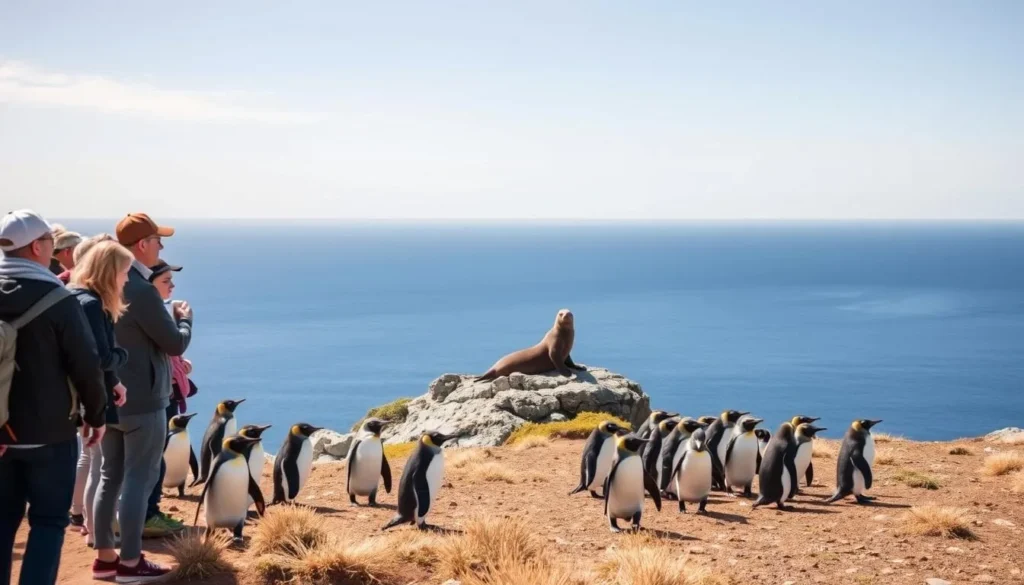
Weather Conditions and Temperatures
Summer brings the most favorable weather conditions to the Falkland Islands, with temperatures averaging 10-15°C (50-59°F). Although it’s the warmest period, the temperature can drop significantly in the evenings, so it’s essential to pack layers. The extended daylight hours, up to 16 hours in December and January, provide ample time for exploration and photography.
Pros and Cons of Summer Travel
While summer is the best time to visit the Falkland Islands, it coincides with peak tourist season. This means that accommodations should be booked in advance, and popular sites may be more crowded. However, the benefits of witnessing the islands’ vibrant wildlife and enjoying the relatively mild weather make it a worthwhile visit.
Autumn Transition: March and April
You can expect a fascinating transition from summer to autumn during March and April in the Falkland Islands. This period offers a unique experience for travelers, with comfortable sightseeing conditions despite less sunshine and shorter days.
Changing Wildlife Patterns
During March and April, the wildlife in the Falkland Islands undergoes significant changes. Penguin chicks are now fully fledged, while many migratory species, including various whale species, can be spotted in the surrounding waters. This season is ideal for wildlife enthusiasts to observe interesting behavioral changes.
Weather Expectations
As autumn sets in, the weather cools, with temperatures ranging from 7-9°C (45-49°F). Travelers should be prepared for increasing rainfall and stronger winds. However, the golden autumn landscapes offer stunning photography opportunities. By late April, the nights grow longer, and visitors may catch the first glimpses of the southern lights.
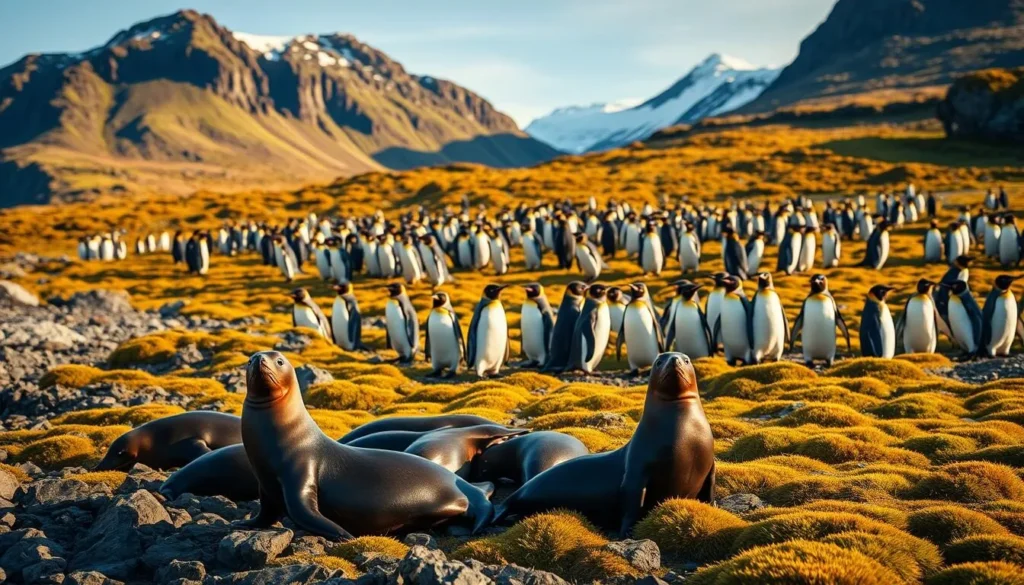
Winter Experience: May to August
Winter in the Falkland Islands brings a unique set of experiences, from cultural events to breathtaking natural phenomena. You can expect a serene landscape, with snow-covered terrains and strong winds.
Weather Challenges and Considerations
The winter season, from May to August, presents significant weather challenges, including temperatures as low as 36°F (2°C) and frequent snow. You should be prepared for limited daylight hours and potential disruptions to tour services.
Liberation Day and Cultural Events
One of the highlights of the winter season is Liberation Day on June 14, commemorating the end of the Falklands War in 1982. You can participate in parades, ceremonies, and community gatherings across the islands, experiencing the local culture firsthand.
Southern Lights Viewing Opportunities
The winter months offer ideal conditions for viewing the southern lights or aurora australis. With minimal daylight and clear, cold nights, you have a high chance of witnessing this spectacular natural phenomenon.
| Month | Average Temperature | Daylight Hours |
|---|---|---|
| May | 40°F (4°C) | 8 hours |
| June | 36°F (2°C) | 7 hours |
| July | 36°F (2°C) | 7.5 hours |
| August | 38°F (3°C) | 9 hours |
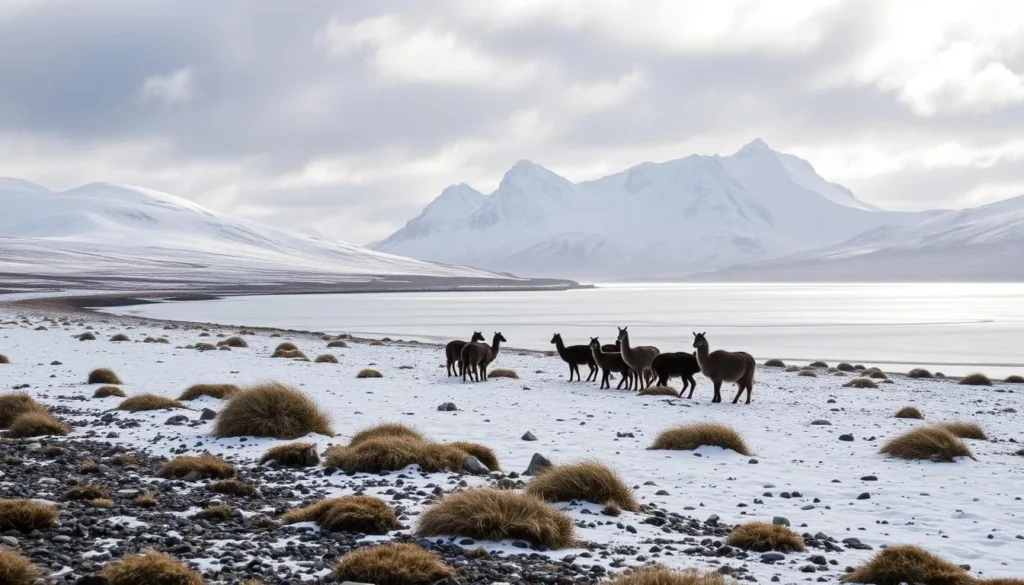
Spring Revival: September and October
As the Falkland Islands emerge from the winter chill, September and October bring a vibrant spring revival. This transitional period is characterized by steadily rising temperatures, making it an excellent time to visit for those interested in witnessing the return of wildlife.
Early Wildlife Returns
The arrival of spring marks the beginning of mating season for many species. Migratory penguins and other wildlife start returning to the islands, making it a fantastic season for birdwatchers and wildlife enthusiasts. With over 200 species documented, including the black-browed albatross and Falkland steamer duck, the Falkland Islands offer a unique opportunity to observe diverse wildlife in their natural habitats.
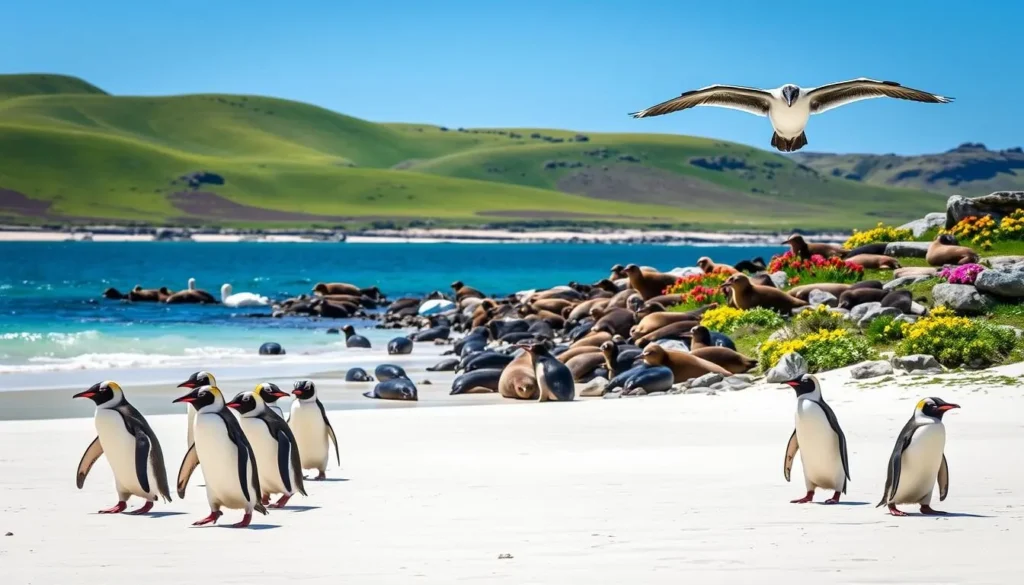
Weather Transition Period
During September and October, the weather remains unpredictable, with lingering winter storms possible alongside increasingly pleasant days. As the period progresses, temperatures slowly climb from 5°C to 8°C (41°F to 46°F), making it essential to pack layered clothing for your visit. The increase in daylight hours, from about 10 to 14 hours, provides more time for outdoor exploration.
For travelers seeking a balance between wildlife opportunities and fewer crowds, the spring months offer an excellent compromise before the peak summer tourist season begins.
Falkland Islands: Best Months for a Weather-Savvy Trip
The best months to visit the Falkland Islands depend on your priorities, whether it’s witnessing wildlife, capturing landscapes through photography, or avoiding crowds. Understanding the seasonal variations is key to a memorable travel experience.
For Wildlife Enthusiasts
If you’re visiting the Falkland Islands for wildlife, the best time is between November and February. During this period, breeding colonies are most active, and you can witness penguin chicks and seal pups making their first appearances in December and January.
For Photography and Landscapes
For those interested in capturing the landscapes of the Falkland Islands, different seasons offer unique opportunities. Summer (November-February) is ideal for vibrant colors and wildlife, while autumn (March-April) provides golden hues, and winter (May-August) offers stark, moody scenes.
For Avoiding Crowds
If your priority is to avoid crowds when you visit Falkland Islands, consider the shoulder seasons of October-November or March-April. These periods offer a balance of wildlife activity and fewer tourists, making for a more serene travel experience.
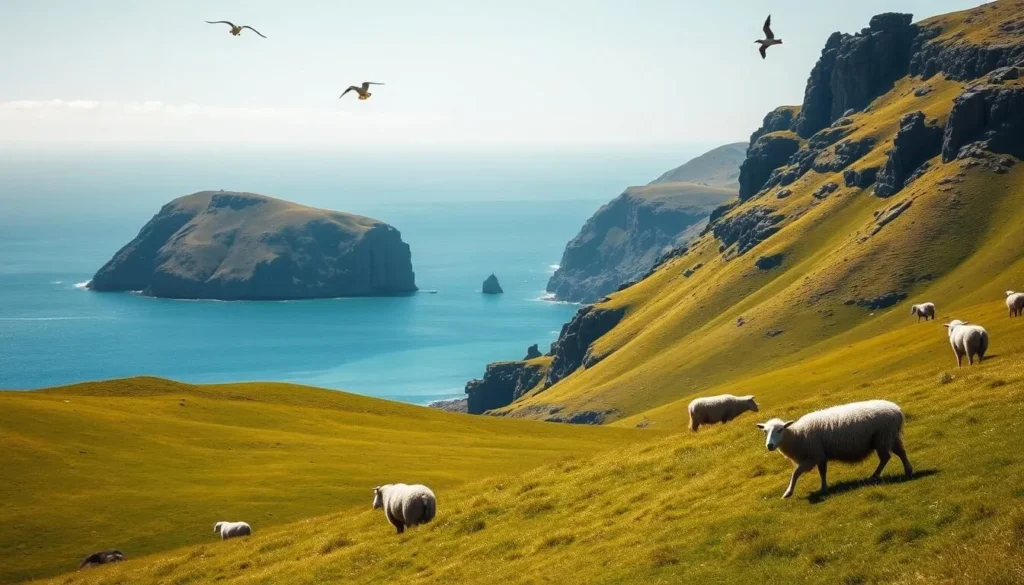
Regardless of when you choose to visit Falkland Islands, it’s essential to book in advance, especially during peak travel months. Each season offers a distinct experience, from the lively summer to the peaceful winter, ensuring an unforgettable journey in this remote destination.
Conclusion: Planning Your Weather-Perfect Falklands Adventure
To plan a weather-savvy trip to the Falkland Islands, you must consider the time of year that aligns with your interests. The islands have a cool, windy climate, with two main seasons: the Austral summer and winter months.
The best months to visit Falkland Islands are between November and February for the most rewarding wildlife encounters, while October and March offer a balance of wildlife activity and fewer crowds.
When planning your trip, remember that the Falkland Islands weather can be unpredictable. Packing layers, waterproof gear, and wind protection is essential. Align your travel dates with your specific interests, whether it’s penguin breeding season or the southern lights.
By choosing the right time to visit, you’ll be rewarded with extraordinary landscapes, remarkable wildlife, and an authentic experience in one of the world’s most unspoiled destinations.
—
The above is subject to change.
Check back often to TRAVEL.COM for the latest travel tips and deals.
